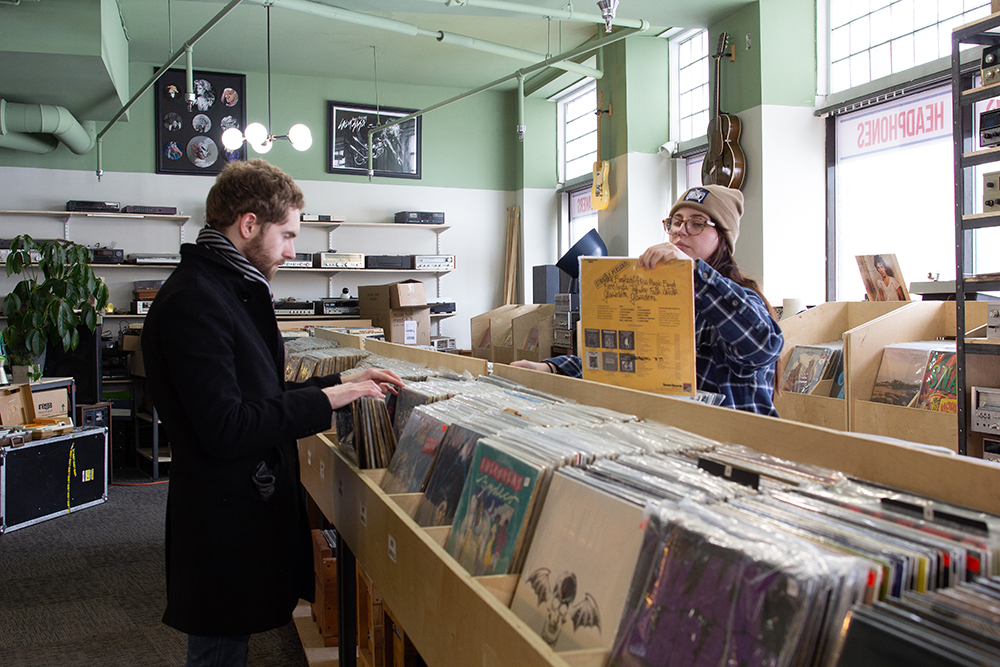Fargo musician looks to past for inspiration for future

Indie musician Jake Ingamar is at home among the bins of the record store, fingers deftly flipping through the stacks in search of the Beach Boys’ “Surf’s Up” or a rare Big Star release.
“Hearing the experience of an album (in vinyl) is just so much better. I mean, some songs are just better when they’re in the middle between two other tracks,” Ingamar mused during our interview at Vinyl Giant Wednesday, Feb. 13.
Interestingly, growing up around his father’s record collection didn’t initiate the spark that led to an obsession with vinyl. Instead, a trip to Moorhead’s Mother’s Records was the beginning. “I remember going to Mother’s Records once when I was like 17 or something and seeing ‘Born to Run’ by Bruce (Springsteen). I was like, ‘Oh, I’ve got to have that record,’ and I didn’t have a record player for like the next two years. I started buying records before I ever bought an actual player.” Ingamar added that he believes his adoration for records really stems from his love and appreciation of music in general.
Ingamar’s obsession reached its peak in college, when he often gave into temptation at the since closed Phat Kat Antiques and Vinyl. “I found the greatest records there. I remember I walked out with like Led Zeppelin’s ‘Physical Graffiti,’ Beatles’ ‘Revolver’ — I would go there every week.” The habit easily took a financial toll, as Ingmar would go with the intent of spending no more than $20 and leave having spent much more.
The 25-year-old’s love for vintage sound extends to the studio, preferring the tape of a reel-to-reel over digital recording. “With digital, you can take like 200 takes, but then with tape you have a limited amount. It makes you more creative, but also gives you more pressure to get the take.” The saturation and transparent 3D sound experience that analog recording gives is what draws Ingamar in. “Digital is like a brick wall. Somehow, whether it’s the vinyl that does it or if it’s tape or something, it gives it (the music) a more transparent 3D sound. It sounds more full to me.”
As a perfectionist, Ingamar said knowing when something is “good enough” to move on from is a valuable lesson he learned from recording and producing his own music. “I just have to settle with it. With vocals, you have to get in that mindset where you’re not trying. It’s such a weird thing because if you tell yourself, ‘OK, I’m going to do vocals. I’m going to nail it. I’m going to try,’ it ends up sounding forced.” Ingamar tied it back to tape by pointing out the necessity of this nonchalance due to the medium’s finite space.
The young multi-instrumentalist has even converted his father’s 1963 bus into his very own recording space (in the summer, of course) aptly named Greyhound studios. While none of the tracks of “Antiques” are recorded in the bus, Ingamar admitted most of them were written there. “Most of them (the songs) were conceived there. It’s fun out there. It helps me to focus. It’s really peaceful in rural North Dakota.”
With plenty of room after removing the seats, the bus houses a drum kit, amps and Logic Interface along with the true essentials of a coffee maker and a comfortable couch. “There were days where I would write for seven or eight hours and I just felt great. I’d have a full productive day and write like 10 songs.”
Ingamar mused that while he still has some tweaking to do in reference to proper sound, hosting other bands in his unique studio could be down the road. “It would be kind of cool if I ever got a thing going to actually run a studio out of there and have other bands record out there.”
As one of 12 recipients of the Jade Presents/Arts Partnership grants, Ingamar is planning on using the funds to help finance his next album. The problem for Ingamar now is deciding how the money will be used. “The studio I’d like to record at is in Nashville. It’s called Welcome to 1979 Studio, and it records specifically to tape. It’s all analog, and they have a vinyl mastering suite.” While Ingamar has found his ideal studio, he isn’t ready to pull the trigger, as the cost is high. “I don’t really want to just go down there and record and use it all up. I’d like to use some of it for professional mixing and mastering. “
Not surprisingly, one of Ingamar’s dreams is to have his music pressed on vinyl, but there again, money plays a big role. “I was just researching this the other week, and you can’t really go into it planning on making any money. It’s just something to do for yourself because it’s a big achievement. I hope that in time it (pressing to vinyl) will, but I don’t know how soon it will be right now.”
It is always a great honor to spend time with a talented musician, especially when given the opportunity to discuss a mutual love of the analog music of the past. As Ingamar observed at the end of our interview, “We could be here until close.”
